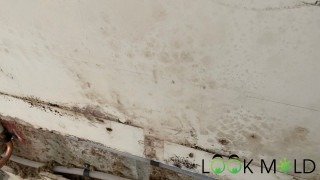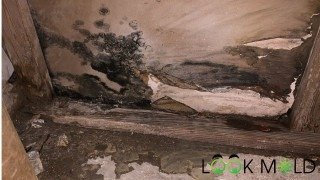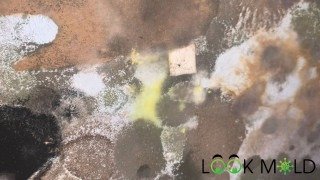Mold on Drywall: Quick, Safe & Effective Guide to Remediation
Expert insight by: Brad Fishbein, Licensed Mold Assessor
Updated January 31, 2023
There are two things that most buildings have:
Mold and drywall.
If you put those two together then mold on drywall can be a big problem.
A mold problem on drywall can be very dangerous because the material used to compile drywall is mostly made of paper. Stachybotrys which is referred to as black mold tends to grow easier on drywall easier than other types of building materials when under the right conditions.
So, what can you do to keep your building safe?
The first thing you need to understand about mold is that it attaches to damp surfaces and spreads. These infestations may start small, but over time they can overwhelm your entire space.
Mold can grow on many different surfaces too! When you think of mold, you may think about fabric or carpeting as the most common place to find it.
One of the smoothest places for mold to attach is drywall. Black mold on drywall is more common than you may know. You may not think of your walls as the starting point for mold outbreaks, but they often are.
There are a few ways to avoid mold or black mold on walls, but first, it’s vital to understand how drywall affects mold spores.
In this article we will go over:
- The Qualities of Drywall
- How Mold Grows on Drywall
- How to Remove Moldy drywall
- How to prevent mold growth on drywall
The Qualities of Drywall
Drywall is a common building material-- and for good reason! The material is called drywall because, unlike certain other materials, it doesn't need water for installation. Instead, its sheets hang from the wood or metal studs that frame the space. From there, it’s taped and sanded to stay in place.
Plaster, for instance, has to be applied with water. That means that a construction crew can't move on to the next layer or part of a project before the plaster has finished drying.
It’s faster to install drywall, allowing construction projects to move along without the long wait times for plaster. So, it’s often the preferred material in quick projects.
Oh, it's also cheaper and that's part of the reason why they are more common in modern homes.
Before understanding why mold thrives on drywall, it’s crucial to know its components and how they get utilized.
Components of Drywall
Knowing what makes drywall can help you understand why it’s threatened by mold.
Drywall is primarily composed of gypsum, a sedimentary rock often used in fertilizers, some creams, shampoos, etc. This rock forms when seawater evaporates from areas rich in minerals.
To construct drywall, gypsum is ground into a paste, spread between two sheets of manila paper, and heat. Although gypsum has a high water content, when heated and dried, it forms crystals, making it solid.
Different brands and types of drywall may use several additives in the paper and gypsum, so it helps to know the type of drywall to understand how mold may spread through it. Sheetrock, for example, is often used interchangeably with the word “drywall,” but it does refer to a specific brand of it.
Even though sheetrock seems like it might be solid, don’t forget that it’s just as guilty of growing mold as other brands. Having black mold on sheetrock is just as dangerous as any other type!
In recent years, however, more eco-conscious brands of drywall have begun to gain popularity. Instead of being constructed of gypsum paste, these drywalls get made from agricultural products like wheat, grass, straw, and even hemp.
Why Does Mold and Black Mold Thrive on Drywall?
Mold can grow on just about any surface exposed to moisture, either directly from water or humidity in the air. It's just a matter of whether or not the mold uses the surface as a food source. Mold will only use porous materials as a food source.

Because drywall gets constructed of layers surrounded by paper, it’s a porous material. Think about all the most difficult-to-reach places where mold grows, like clothes, curtains, and carpets. Mold thrives on porous surfaces!
Unfortunately, growing mold is easy and can happen on just about any kind of drywall. There are a few conditions that must be met for mold to start growing and spreading in your building.
Ideal Conditions for Mold and Black Mold Growth
Most mold species can’t grow when it’s too cold. That’s why you don’t see mold in your refrigerator or your freezer, even though they’re damp and high in moisture!
Like all organisms, mold requires food, water, and oxygen to grow and thrive. Almost any organic matter feeds a mold, including wood or fabric. Since drywall isn’t airtight or in a vacuum, there’s plenty of oxygen to go around for mold and its spores.
If your building has a constant supply of moisture in the air, the conditions are perfect for mold to attach to your drywall. Humidity and water damage are two of the most common catalysts for an outbreak of mold or black mold.
The wood particles in and around the drywall provide a steady source of nutrition for the mold. The wood then traps the moisture from the air, feeds the mold, and helps spread its growth.
How Do I Know If I Have a Mold Growing on the Walls in My Building?
There are a few different ways to tell if you have an outbreak of mold in your building. You may notice a musty smell first. Mold releases a distinctive scent while it grows.

Additionally, you may notice mold spots of discoloration, including black spots, around certain areas. If you see what you think is mold, you may want to verify your suspicions. That is where mold testing comes in handy!
It takes more than knowing what type of mold you have and its source to determine how affected your building is. Air testing is one way to test if you have mold spores in the air. Spores can become airborne from moldy drywall and travel through the HVAC system.
Wall cavity testing for mold can also be done to test the interior walls in the home.
Hiring a mold assessor can help you make an educated decision about what to do with mold in your building. It’s better to check now and be sure than to wait until you get allergy symptoms or are surprised by a hidden leak in your plumbing.
How Mold Grows on Drywall
Now that you understand why mold can grow and spread on drywall, it’s crucial to learn how it propagates.
Mold spreads by releasing spores into the air, which travel to a new, nearby surface. They attach to moisture and feed on their organic surroundings. It also doesn’t require sunlight, so dark, damp places are the best for their growth.
The two most common ways for a building to retain moisture are humidity and water damage.
How Water Damage Affects Drywall
Water damage can create a constant moisture supply and grow mold the fastest. Mold generally develops on drywall between 24-48 hours after exposure to water. This largely depends on whether the water damage occurred in humid areas of the home.

Once mold spores attach and start feeding on their surroundings, they begin to colonize until it gets destroyed. From that point, they spread to do it all again.
And if black visible mold starts to grow, it's not just spores that it produces, it can start to off-gas and produce mycotoxins.
If moisture from a leak or water damage isn’t addressed immediately, it damages your drywall. The moisture causes drywall to lose its structural integrity and grow soggy. That makes it weak, soft, and especially prone to mold growth.
How to Remove Mold on Drywall
One of the misconceptions about microbial growth is that killing mold or cleaning mold in an affected area is the proper method to get rid of mold.
When it comes to drywall specifically, the goal is not to kill black mold or any type of mold for that matter.
Dead mold can be a health hazard just as active mold growth.
When left untreated, mold can cause a whole host of health problems. These can range from the short-term to the long-term but more studies need to be conducted. They can also be mild to moderate or severe.
Removing surface mold on non-porous materials such as shower walls can be removed with a cleaning solution but it is not recommended on drywall (or any other porous materials that have been water damaged.
Now:
There is such a time when mold can be treated on drywall instead of removing mold. This is when mold is superficial and is present due to mild condensation. In this case, mold is just growing on the surface and the drywall isn't being used as a food source. In this situation, the walls can be vacuumed with a HEPA filter and sealed with a mold resistant paint.
Resist using a bleach solution to remove mold from walls as the bleach does not penetrate drywall very well. The same goes for a borax solution used for killing mold.
When Do I Need Mold Remediation?
Once you notice that you have mold on the walls or black mold on drywall, you’ll need to determine how far its spread is. For spaces less than ten square feet with mold, you may be able to avoid mold remediation by taking care of the mold removal yourself.

If you suspect that your space has mold in more than just a few small affected areas, however, mold remediation may be necessary.
Keep in mind just because you see microbial growth on the front part of the drywall, it doesn't mean there aren't more than 10 square feet of mold inside the walls.
How Does Mold Remediation Work?
Mold remediation is different than regular removal. Remember, it's not enough to just kill mold. Unlike mold removal, remediation works to clear a large amount of mold from a premise through a rigorous process. The main purpose of mold abatement in the home is to protect the mold from cross-contaminating with other areas when removing mold.
First, the remediators will come and investigate your space. They will need to determine what the source of mold is. If your mold outbreak originated from a leaky pipe, they need to determine what sort of leak you have.
Even though remediators don’t do the work of a plumber, they can be a valuable asset in determining where in the building the leak originates.
Once they discover the source of your mold outbreak, they’ll need to contain the affected areas with plastic sheeting. To understand how mold takes effect, think of it like an airborne virus. The place with mold needs containment so that no further contamination spreads.
Spores from mold travel by air and can spread quickly through an area. They travel along lengths of drywall and can reach other susceptible parts of your building through the walls themselves. That’s why it’s vital to contain the area before continuing any next steps. Containment also includes sealing the HVAC vents.
After containment, the remediators will remove the affected drywall and other areas following safety guidelines. The exact process of removal depends on the location of the mold. Where the mold is in your building, and how accessible it is, makes a difference in the cleanup method.
Additionally, certain materials require a different approach than others. While drywall will most likely need to be removed, it is necessary to kill mold on structural materials such as wood or steel.
Once the mold is killed by the remediators, they will clean and sanitize all affected areas. All remaining surface mold will be cleaned. They’ll also deodorize the air since mold often leaves a musty scent when it overwhelms a space.
It is important to use a mold remediation specialist instead of doing it yourself because while it's not hard, it is an art form. Proper PPE needs to be used.
A third-party mold assessor should ensure the remediation has been done and is successful prior to new drywall being hung.
How to Prevent Mold on Drywall
Since there’s no guaranteed way to remove mold in any place, it’s vital to know ways to prevent the growth of harmful molds inside. The following are a few recommended ways to prevent mold from growing in your building.

Keep Humidity Low
While indoors, humidity can cause your drywall to be a breeding ground for mold, black mold, and mildew. The higher the humidity, the more moisture is trapped in the air. That means surfaces are more likely to be damp, which leaves more places for mold to attach.
Keeping air conditioning consistently cycling as can help remove excess moisture from the air.
Fix Leaks Immediately
It may seem like a no-brainer, but the longer a leak remains untreated, the more water flows into drywall. Pipes run through the walls, ceilings, and floors of buildings. All of those places are especially susceptible to mold growth.
As soon as you notice a leak or suspect one, call a professional immediately to get it fixed. That helps keep your drywall from retaining too much moisture.
Completely Dry Water Damage
If you notice a leak, don’t panic! Act quickly and thoroughly dry all water-damaged areas so you won’t have to remove mold from the drywall later.
This should really be done by a water damage restoration company because of the fact so much equipment is needed to properly dry out a large-scale leak properly.
Install Mold-Resistant Drywall
Although regular drywall is moisture-resistant, it’s not necessarily resistant to mold. Mold-resistant drywall uses fiberglass mesh instead of the standard paper as its outside layers.
This mesh is a non-organic material, fiberglass, that keeps the mold from having a food source. Since mold can only feed on organic material, it effectively won’t be able to grow and spread with this material.
So, the question is if mold-resistant drywall is worth the investment to keep mold from growing on your drywall.
Mold-resistant drywall is a bit more costly than standard drywall, so cost is a factor in your decision. Additionally, although the product claims to be mold-resistant, it’s by no mean mold-proof or water-proof.
In areas with dry heat or low humidity, installing resistant drywall may not be cost-productive. This type of drywall is best served in areas with high humidity or places with a history of problems with mold or mildew.
Understanding how to detect, remove, and prevent mold is vital to keeping your building safe and clean. There are many different ways to do so, but it’s always important to know your stuff! Don’t forget to be your best asset and do your research too, so mold doesn’t get the better of you or your space!
Explore Related Topics:

Meet the author: Brad Fishbein is an ACAC council-certified Microbial Investigator. In the fall of 2012, he became a Licensed Mold Assessor in the State of Florida through the Department of Business & Professional Regulation. Brad has helped homeowners with over 5,000 successfully completed Mold Inspections since 2009.

